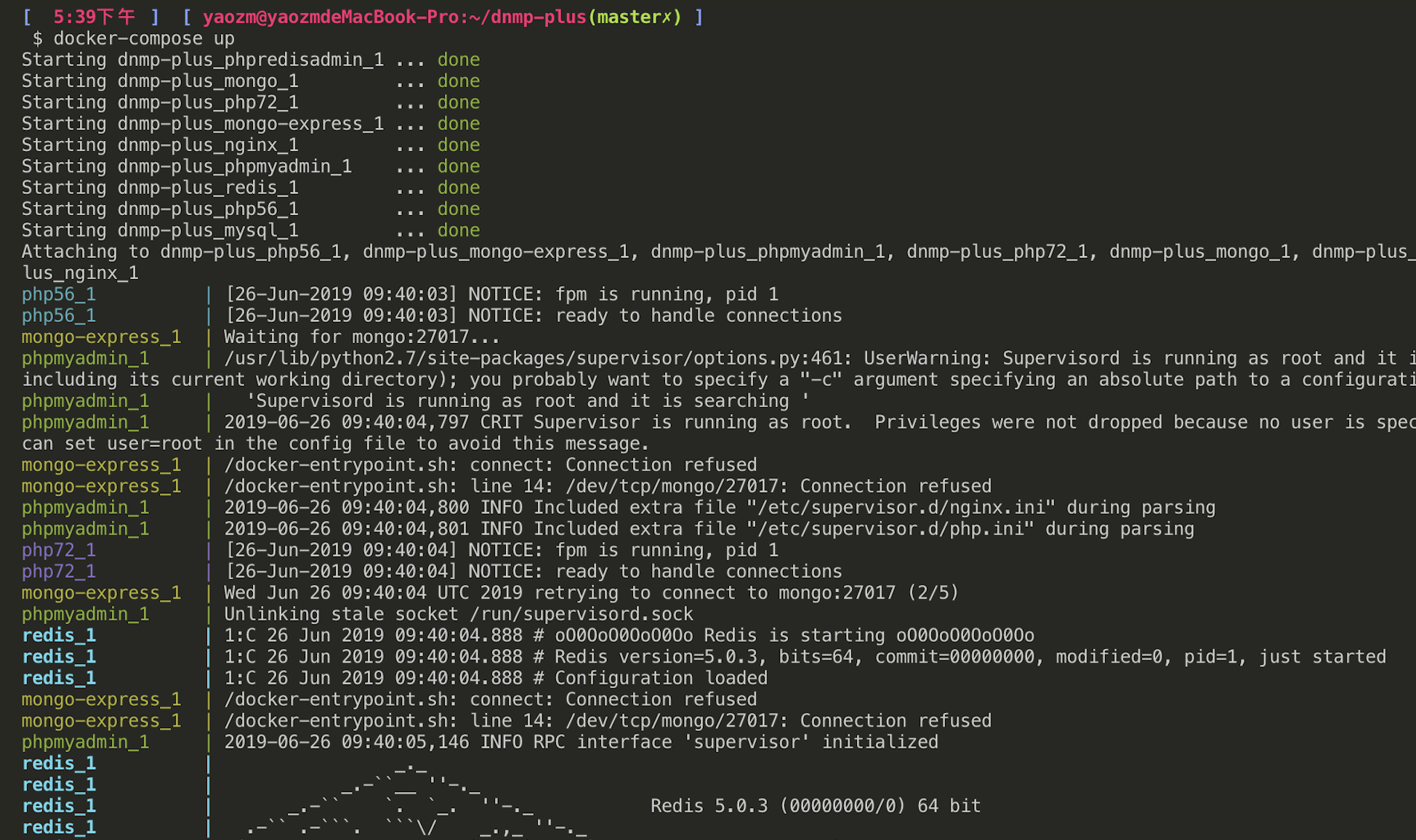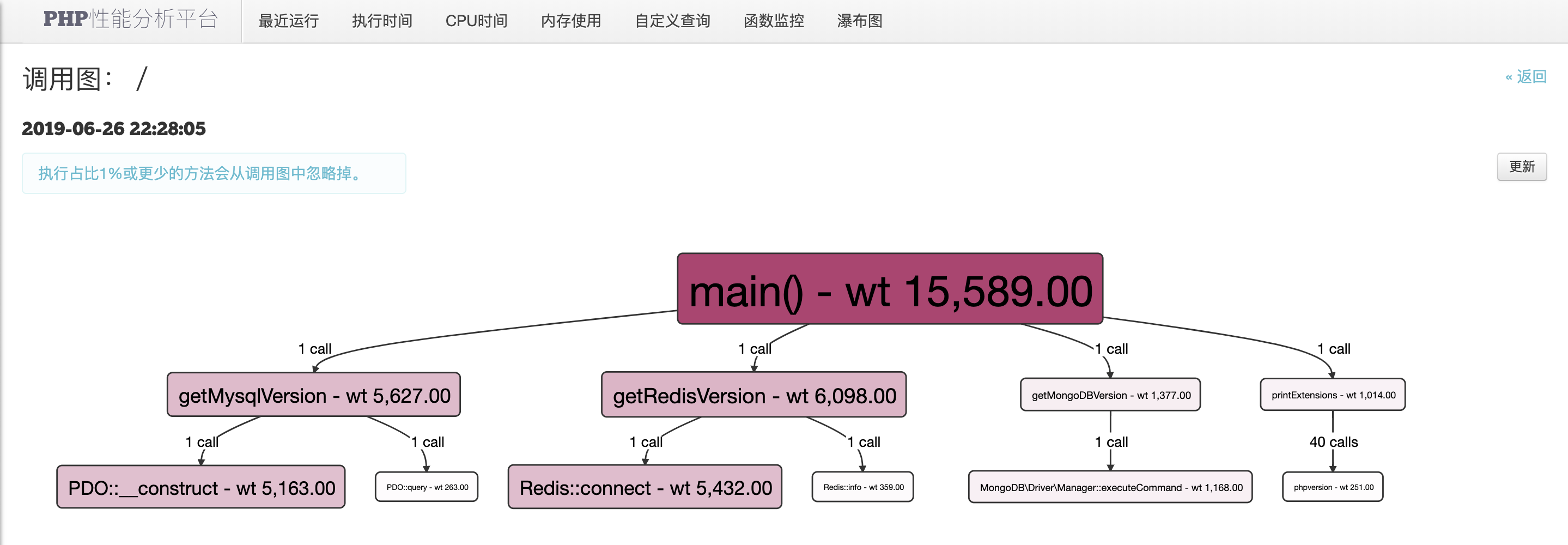DNMP PLUS
dnmp = Docker + Nginx + MySQL + PHP + Redis + MongDB
plus = xhgui + xhprof + tideways
dnmp-plus = PHPer's one-click installation development environment + PHP non-intrusive monitoring platform(optimizing system performance, positioning artifacts of Bug)
| 简体中文 | English |
dnmp-plus is added on the basis of dnmp:
- PHP xhprof extension - PHP performance tracking and analysis tool developed by Facebook
- PHP tideways extension - branch of xhprof with support for PHP7
- PHP mongodb extension
- MongoDB service
- Mongo Express - MongoDB Service Management System
- Xhgui - xhprof GUI system for analyzing data data

Directory Structure
├── .github Github 配置目录
├── conf 配置文件目录
│ ├── conf.d Nginx 用户站点配置目录
│ ├── mysql.cnf MySQL 用户配置文件
│ ├── nginx.conf Nginx 默认配置文件
│ ├── php-fpm.conf PHP-FPM 配置文件
│ ├── php.ini PHP 配置文件
│ ├── redis.conf Redis 配置文件
├── docs 文档目录
├── extensions PHP 扩展源码包
├── log 日志目录
├── mongo MongoDB 数据目录
├── mysql MySQL 数据目录
├── www PHP 代码目录
├── Dockerfile PHP 镜像构建文件
├── docker-compose-sample.yml Docker 服务配置示例文件
├── env.smaple 环境配置示例文件
└── travis-build.sh Travis CI 构建脚本
Environmental requirements
- Docker
- Docker-compose
- Git
Quick use
$ git clone https://github.com/guanguans/dnmp-plus.git --recursive
$ cd dnmp-plus
$ cp env.sample .env
$ cp docker-compose-sample.yml docker-compose.yml
# Service option:nginx、php72、php56、mysql、mongo、redis、phpmyadmin、phpredisadmin、mongo-express
$ docker-compose up -d php72 nginx mysql mongo
OK, you now have a dnmp-plus development environment, the default web root directory www/localhost/, the browser accesses http://localhost

Basic use
# Service option:nginx、php72、php56、mysql、mongo、redis、phpmyadmin、phpredisadmin、mongo-express
# Create and start containers
$ docker-compose up 服务1 服务2 ...
# Create and start all containers
$ docker-compose up
# Create and start deamon containers
$ docker-compose up -d 服务1 服务2 ...
# Start services
$ docker-compose start 服务1 服务2 ...
# Stop services
$ docker-compose stop 服务1 服务2 ...
# Restart services
$ docker-compose restart 服务1 服务2 ...
# Build or rebuild services
$ docker-compose build 服务1 服务2 ...
# Execute a command in a running container
$ docker-compose exec 服务 bash
# Remove stopped containers
$ docker-compose rm 服务1 服务2 ...
# Stop and remove containers, networks, images, and volumes
$ docker-compose down 服务1 服务2 ...
For xhgui use, you can refer to https://github.com/guanguans/guanguans.github.io/issues/9
installation
Installation
$ cd www/xhgui-branch
$ composer install
Modify the xhgui-branch configuration file www/xhgui-branch/config/config.default.php
<?php
return array(
...
'debug' => true, // changed to true for easy debugging
'mode' => 'development',
...
'extension' => 'tideways', // changed to support tideways for PHP7
...
'save.handler' => 'mongodb',
'db.host' => 'mongodb://mongo:27017', // 127.0.0.1 changed to mongo
...
);
Added in the hosts file
127.0.0.1 xhgui.test
Browser access http://xhgui.test

Modify in the nginx configuration file to analyze the project, with the default localhost configuration conf/conf.d/localhost.conf as an example
...
location ~ \.php$ {
fastcgi_pass php72:9000;
fastcgi_index index.php;
include fastcgi_params;
fastcgi_param PATH_INFO $fastcgi_path_info;
fastcgi_param SCRIPT_FILENAME $document_root$fastcgi_script_name;
# 在执行主程序之前运行我们指定的PHP脚本
fastcgi_param PHP_VALUE "auto_prepend_file=/var/www/html/xhgui-branch/external/header.php";
}
...
Restart nginx
$ docker-compose restart nginx
The browser visits http://localhost](http://localhost) and then visits http://xhgui.test. Now that you have the content, you can enjoy the performance tracking and analysis of the project


PHP and extensions
Switch the PHP version used by Nginx
By default, both PHP5.6 and PHP7.2 2 PHP versions of the container are created. Switching PHP only needs to modify the fastcgi_pass option of the corresponding site Nginx configuration. For example, the example http://localhost uses PHP7.2, Nginx configuration:
fastcgi_pass php72:9000;
To use PHP 5.6 instead, change it to:
fastcgi_pass php56:9000;
Restart Nginx to take effect
$ docker-compose restart nginx
Install PHP extensions
Many of PHP’s features are implemented through extensions, and installing extensions is a slightly time-consuming process, so in addition to the PHP built-in extensions, we only install a few extensions by default in the env.sample file. If you want to install more extensions, please Open your .env file and modify the PHP configuration as follows to add the required PHP extensions:
PHP72_EXTENSIONS=pdo_mysql,opcache,redis,xdebug,mongodb,tideways
PHP56_EXTENSIONS=opcache,redis,xdebug,mongodb,xhprof
Then rebuild the PHP image
docker-compose build php72
docker-compose up -d
Use Log
The location where the Log file is generated depends on the value of each log configuration under conf.
Nginx Log
The Nginx log is the one we use the most, so we put it under the root directory log. The log directory maps the /var/log/nginx directory of the Nginx container, so in the Nginx configuration file, you need to output the location of the log. We need to configure it to the /var/log/nginx directory, such as:
error_log /var/log/nginx/nginx.localhost.error.log warn;
MySQL log
Because MySQL in the MySQL container uses the mysql user to start, it cannot add log files by itself under /var/log. So, we put the MySQL log in the same directory as data, the mysql directory of the project, corresponding to the /var/lib/mysql/ directory in the container.
Configuration of the log file in mysql.conf:
slow-query-log-file = /var/lib/mysql/mysql.slow.log
log-error = /var/lib/mysql/mysql.error.log
Database management
- Default phpMyAdmin address: http://localhost:8080
- Default phpRedisAdmin address: http://localhost:8081
- Default Mongo Express address: http://localhost:8082